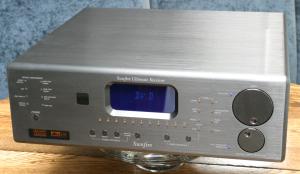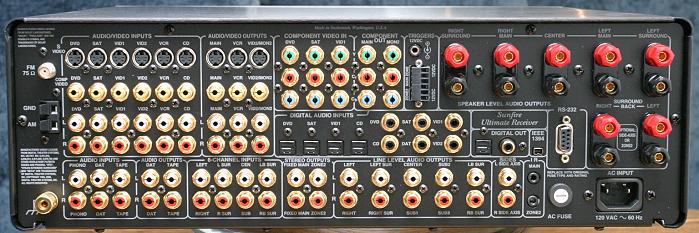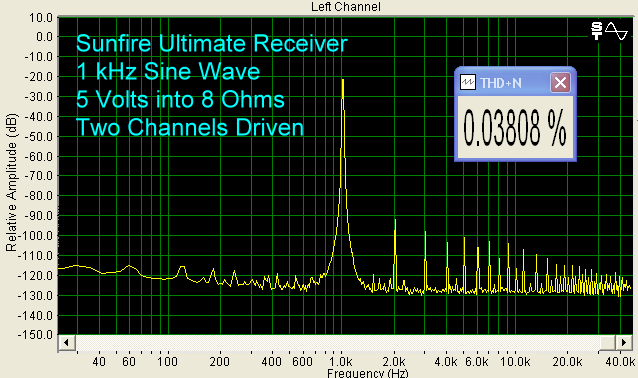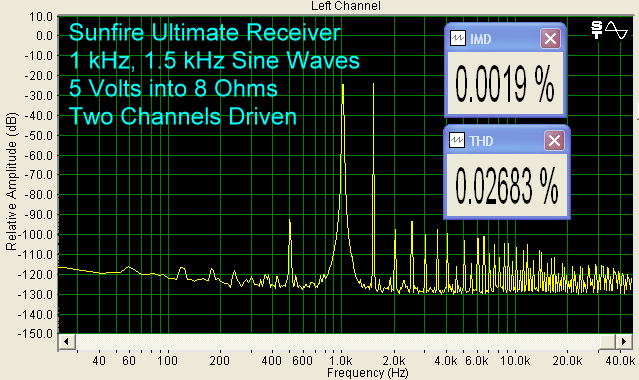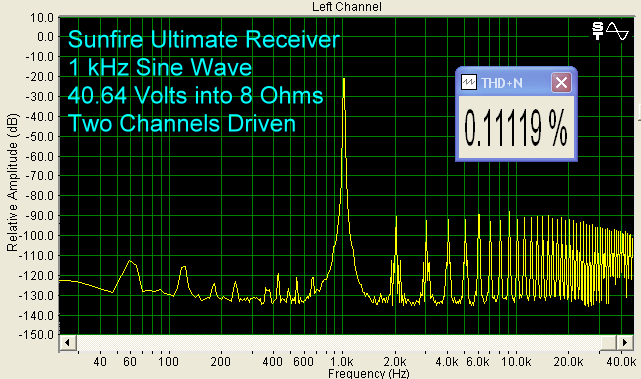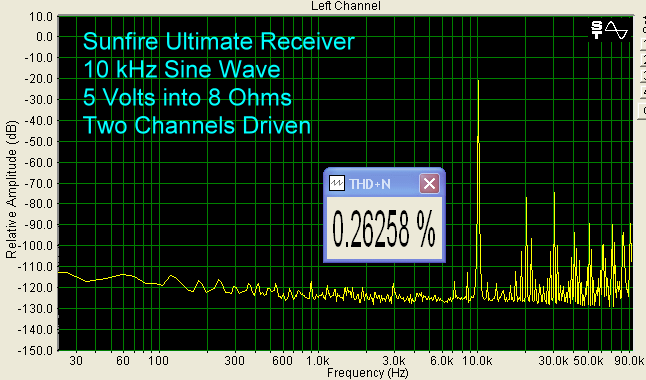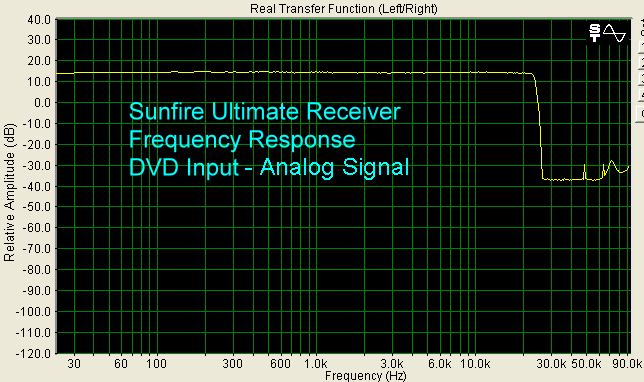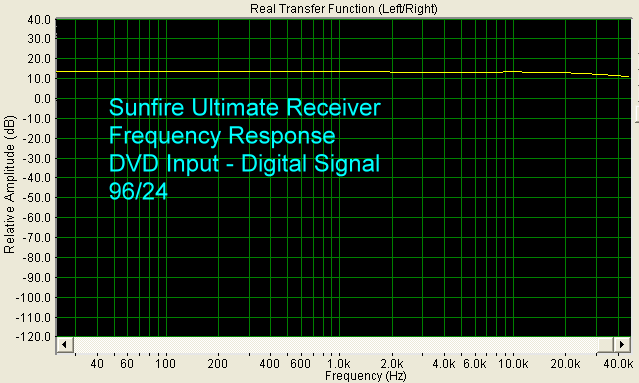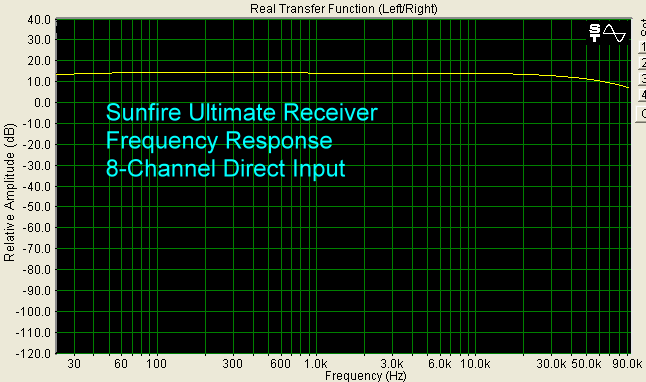|
||||||||||
|
Introduction The Design The Ultimate also is unusual in that it is rated at 200 watts x 7. Most receivers top out at no more than about 150 watts per channel. The reason for this is that it takes a very big power supply to deliver all those watts, and with Class A/B operation, which most receivers are, this limits the size of the transformer and capacitors that can fit in the chassis along with the fins to dissipate the heat. With the Sunfire, and Bob's Tracking Downconverter technology, the power supply does not have to be so big in order to deliver tons of power. (A Class A/B amplifier with 200 x 7 might weigh 120 pounds.) The downconverter maintains a voltage on the output devices that is just above the signal requirements. Normally, the "rail voltage" on the output devices is constant, and is the maximum voltage that the amplifier can deliver. The difference between the rail voltage and the signal voltage requirement has to be dissipated as heat. Since the Sunfire does not do it this way, it runs cool, and there is always plenty of power reserve in the capacitors. The Ultimate chassis is standard for Sunfire products (another clever way of keeping costs down, which translates to excellent prices for the consumer). The front plate has a window for the LED panel readouts, which specify the input (DVD, VCR, Tuner, etc.), and such things as Tone Controls (± 10 dB for treble and bass), and DSP Modes (Party, Jazz Club, Dolby Pro Logic II, DTS Neo:6, etc.). The left side of the front panel has indicator lights which are illuminated when certain features are active, such as DD, DTS, Dolby Pro Logic II, and Holographic Imaging. To the right of that is an IR sensing window, for the remote control, Tuner preset buttons, the main LED window, and then buttons which are the same size as the indicator lights on the left, but they can be pressed to activate functions, such as selecting modes, treble and bass, Holographic Imaging, and Mute. Sunfire's Holographic Imaging is a very clever circuit. Its effect is to widen the soundstage, and here is how it works. When you are sitting in front of two speakers, your left ear hears mostly the left speaker, but also some of what is coming out of the right speaker. Your right ear hears mostly the right speaker, but also some of the left speaker's output. This reduces the soundstage width. Holographic Imaging takes a little of the left speaker output, inverts it, and sends it to the right speaker. It correspondingly takes some of the right speaker output, inverts it, and sends it to the left speaker. The effect is to reduce the amount of right speaker output heard by the left ear, and to reduce the amount of left speaker output heard by the right ear. This widens the soundstage. It really does work nicely for stereo music listening. Of course, there is always a price for any signal manipulation, and I found that it reduced the amount of detail in the sound, probably because each speaker was now trying to reproduce a bit of the other channel along with its own signal. However, it is a very interesting feature, and depending on the music, I turned Holographic Imaging on or off by just pressing the button. The rear panel is a plethora of jacks. The difference between the receiver and the processor (Theater Grand III) is that the receiver has speaker binding post outputs, while the processor has RCA and balanced XLR line-level outputs. (The Ultimate does not have XLR connections.) Other than that, the array of connectors is very similar. There are plenty of A/V inputs, with composite and S-Video connectors, along with a set of three component video inputs and two component video outputs. These days, consumers are moving towards component video for DVD players, and the other two sets can be used for satellite and one other source. The AC input receptacle is two-pronged, ungrounded. There are RS-232 and Firewire inputs for future purposes, but for upgrading the software, of which there is a current upgrade available on the Sunfire website, you burn it to a CD and play it with the player connected to the receiver. There are line-level pre-ins and pre-outs for all channels, along with a pair of line-level outputs for 9.1 operation, but you need one more stereo power amplifier for this. The receiver has seven channels of 200 watt power amplification, including side surround and rear surround for ES operation. It is too bad that 7.1 has not been adopted by movie producers, but the circuitry in 7.1 receivers generates the extra channels from 5.1 sources, which does seem to work fine in all the receivers I have tested. Even though the Sunfire goes one step further by letting you generate yet another pair of channels with 9.1 processing, 7.1 is plenty for me, as I don't know where I could put yet another set of speakers. But those of you with more room might find this idea intriguing as more speakers means more soundstage. Note that Dolby has now announced Dolby Pro Logic IIx (http://www.dolby.com/events/CEDIA/PLIIx/), so it looks like 7.1 will be more useful in future receivers that have 7.1 processing. Click Photo Above to See Larger Version The
remote control is one of the nicest I have seen, and is the same one used
for the Theater Grand III. (Click on the photo
to see a larger version.) The only complaint I have here is that you need to use the remote in order to adjust individual channel volume, such as right front in relation to left front. I have always preferred channel volume adjustment to be something that has buttons for each channel on the remote, and that you don't have to go through menus to do, but since a few years ago, those functions have been moved into a menu for just about every manufacturer. Plus, with the Sunfire, you need to be looking at the OSD (On Screen Display) for setting the individual volume on the fly (while watching a movie), and text on the screen along with the movie action is distracting. Lastly, the OSD is not available at the component video outputs, so that is an additional problem to deal with when you need to see the OSD. If you have PIP, you could connect the S-Video output from the Ultimate to the S-Video input on the TV and that should solve it. However, it is an aggravation. Other than this, the remote operates smoothly and easily, and seems to have been well thought out. The Ultimate has bass management for adjusting the bass crossover between 40 Hz and 160 Hz. My electrostatics are full range speakers, and I like to use a crossover of about 50 Hz so that the Mylar membranes don't slap against the stators during loud, deep passages. So, the extensive crossover options of the Sunfire are very useful to me, as I find the 80 Hz standard crossover setting, which is the only crossover frequency available in some receivers, inadequate. Speaker distance (for delay settings) is in feet with the Sunfire. It would be much better to have more precise settings in feet and inches. However, at least it is in distance and not milliseconds, which requires an additional calculation to deal with. The Sunfire recognizes which input is receiving a signal if you set it to Automatic, so you don't need to specifically configure each input. You just plug and play. The Sound I tested the Ultimate Receiver with a Toshiba DVD Player and a variety of speakers, including full range electrostatics, which are a challenge for any power amplifier. Cables were Nordost and BetterCables. I also tested the Sunfire as a two-channel setup with a Sony SACD player and Magnepan full range speakers. Cables in this case were Nordost and Analysis Plus. With 200 watts per channel into seven channels plus subwoofer, the Ultimate Receiver is no pussycat. That is a lot of speaker cones moving at the same time, and I have to say the sensation is a thrill ride with that much power. I cranked it up with such movies as "Pearl Harbor" in the attack scene, and it was almost like reliving December 7, 1941. The Pod Race in "Star Wars I - The Phantom Menace" is another reference piece for me, not just because it has exciting sounds all over the room, but because of the dialog being hard to hear with all the engine noises. The Sunfire did not have any problem with this sequence at all. I have 200 watts x 7 in my reference setup, using a Rotel RMB-1095 and another stereo amp for the side channels. The Sunfire, by comparison, is a little more up front in the highs than the Rotel. This can be a disadvantage with harsh soundtracks, so it would be wise to use the Ultimate with speakers that are a bit laid back. Nevertheless, the Sunfire did all movies justice, and if they were harsh, well, that is not the Sunfire's fault. Although the Sunfire has plenty of power, and I have large speakers, I crossed them all over at 50 Hz for the bass. This let the Sunfire be more efficient, and it also reduced the speakers' having to deal with really low frequencies that they don't reproduce well anyway. (This is what I do in my reference setup as well.) So, the Sunfire just coasted along in this configuration, and I was able to watch movies at reference volumes without any problems at all. Even if a typical mass market receiver had a 50 Hz crossover option for the bass, it would not perform like the Sunfire though. All that headroom with 200 watts per channel means you are not getting much distortion at modest power output of, say 50 watts per channel. There really is no substitute for raw power, and the Ultimate Receiver has tons of it. On the Bench Distortion tests were performed using the analog DVD input, in Stereo mode. With 1 kHz input, and 5 watts into 8 Ohms (two channels driven), THD is a very reasonable 0.04%.
IMD with 1 kHz and 1.5 kHz inputs is also low.
Driving two channels, I found that the Sunfire would deliver 200 watts RMS continuous into 8 Ohms (40 Volts), at about 0.1% THD. With the next volume step up on the volume control, it delivered 42.3 Volts at just over 5% THD, which is a clipped signal. So, it appears that 200 watts per channel is pretty close to a brick wall number.
At 10 kHz, distortion is well within spec.
Frequency response through the DVD analog input, using an analog signal and operated in Stereo mode, showed a steep roll-off above 22 kHz
However, when I sent a digital signal (24/96) to the DVD coaxial digital input (they are different jacks than the DVD analog inputs), the frequency response extended to 48 kHz. This is a good reason to use the digital input if you are playing 24/96 music DVDs. (I also tried 24/192 digital signals, but the Ultimate would not decode them.)
When I used the 8-Channel Direct Input (analog), response extended to 96 kHz, and this is desirable when playing DVD-As or SACDs, which have a frequency response far beyond what CDs have.
Conclusions The Sunfire Ultimate Receiver is one heck of a product, incorporating the electronics of the Theater Grand III with high power amplifiers. It has all the bells and whistles of any mass market receiver, but bumps things up a notch by having 200 watts RMS x 7. There really is no other product on the market that does this. It has a nice clean sound, and delivers all the impact that home theater aficionados might ever want.
|
||||||||||

